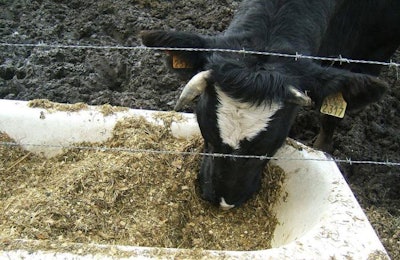
An international team of researchers has explained how a new compound works to reduce the environmental impact of ruminant animals by cutting the production of the greenhouse gas methane.
Researchers at the Spanish National Research Council (CSIC) are part of an international team that has been able to show how a new molecule, 3-nitrooxypropanol (3NOP), inhibits methane production by ruminants. The work is published in Proceedings of the National Academy of Sciences (PNAS).
The potential value of this study is to reduce the environmental impact of ruminants, without adverse effects on the animals themselves. Livestock farming is responsible for 18 percent of the world’s greenhouse gases, and ruminants such as cattle, sheep and goats generate 35 percent of one of these gases – methane.
Ruminants digest their food through fermentation carried out by microorganisms living in the rumen. This process produces organic acids – such as acetic acid, propionic acid, and butyric acid – all of which are absorbed and metabolized by the animal as a source of energy. But, in addition, the process produces methane, which escapes into the atmosphere in the form of gas.
How does it work?
By 2014, scientists had demonstrated the effectiveness of 3NOP in reducing methane production in sheep but they were unaware of how it actually worked.
Now, reports CSIC, the new research using incubated anaerobic microorganisms from ruminants’ digestive systems has revealed how 3NOP only affected the methane-producing microorganisms and not those that contribute to digestion. This points to a reduction in the production of methane without adverse effects on the animal’s health, production or welfare.
“Up until now, no one had described the mode of action of a compound which can repeatedly reduce (by 30 percent) methane production in animals without any risks, either to the animal’s health, or to their productivity,” said David Yáñez, a CSIC researcher at the Zaidin Experimental Research Centre in Granada in southern Spain. “We will see an increase in the efficiency of ruminant production systems as better use is made of the energy taken in in animal feed, given that methane production accounts for a loss of up to 12 percent of the energy an animal ingests.”
This work open up the possibility of reducing methane emissions from ruminant animals and so contributing to a reduction in global temperatures that are influenced by greenhouse gases.
The University of Auburn in the U.S. and the Max Planck Institute in Germany collaborated on this project, as did the Swiss company, DSM Nutritional Products, which developed and owns the patent to 3-nitrooxypropanol.
The scientific paper, by Evert. C. Duin and others, is titled “Mode of action uncovered for the specific reduction of methane emissions from ruminants by the small molecule 3-nitrooxypropanol” and published in PNAS.
More on 3-nitrooxypropanol
According to DSM Nutritional Products, several molecules substituted at various positions with at least one nitro-oxy group have been identified as potential inhibitors of methane production from the digestive system. One of these compounds is 3NOP, which was developed from related compounds that had been identified in lab experiments. Further work showed that 3NOP exhibited a significantly higher potential to reduce methane production than another well-known model compound, bromoethanesulfonate.
A paper by Haisan and others in Journal of Dairy Science in 2014 showed that feeding 3NOP to lactating dairy cows at 2,500mg/day reduced methane emissions, without compromising dry matter intake or milk production.
In 2015, Hristov and others in PNAS found that 3NOP, applied at 40 to 80mg/kg feed dry matter, decreased methane emissions from high-producing dairy cows by 30 percent and increased body weight gain, without negatively affecting feed intake or milk production and composition. This inhibitory effect persisted over 12 weeks of treatment, they added, offering the prospect of an effective methane mitigation practice for the livestock industries.













